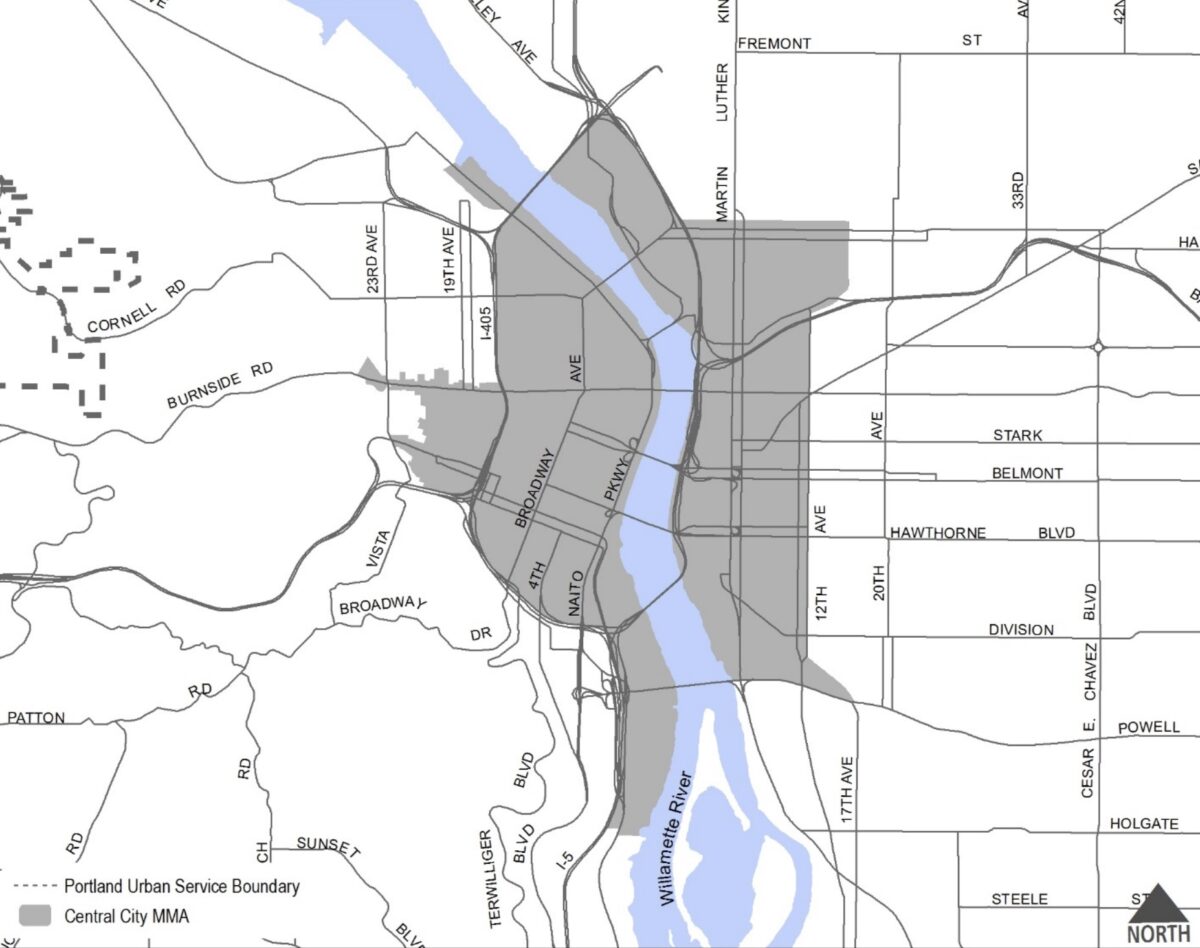
This seems to imply that City would be unable to provide ‘safer and greater’ conditions for bicycling without this project. This is untrue.
– Roger Geller, PBOT
The list of people who have criticized the Oregon Department of Transportation’s latest design proposal for their I-5 Rose Quarter project includes some obvious names (like anti-highway advocacy group No More Freeways PDX) and some more unexpected ones (like the entire Trail Blazers organization). Members of the Portland bicycle and pedestrian advisory committees have also spoken out against the design, which they think will create worse conditions for people biking and walking in and around the Rose Quarter.
It’s one thing for activists and other stakeholders to make strong public statements against a megaproject. It’s another thing entirely when concerns come from another government agency — especially one that’s an official project partner.
Last week we shared what former PBOT Director Chris Warner had to say about the project as part of his official comments on ODOT’s supplemental environmental analysis (SEA, a document required by the federal government as part of the NEPA process). Warner’s statements were backed up by 135 comments from 13 different city staff members, 44 of which came from longtime PBOT Bicycle Coordinator Roger Geller.
We highly recommend taking a closer look at all the comments (one PBOT engineer calls the new southbound ramp a potential “fatal flaw” and the word “misleading” is used three times) — but for now I want to focus on Geller’s and on one thread in particular.
Geller’s comments reveal an interesting (and growing?) tension between ODOT and PBOT about something called the Central City Multimodal Mixed Use Area (MMA). If you came to our Wonk Night event on this project in 2021, you might recall hearing about this. It’s a little-known and relatively technical, yet highly important piece of this project’s puzzle.
An MMA is land use designation cities can receive from the State of Oregon Land Conservation and Development Department (this PDF has a good summary of how it works). Typically, when a city wants to develop urban land with more buildings, housing, and destinations, they are required by Oregon Administrative Rule (Chapter 660, Division 12: Transportation Planning) to expand the road infrastructure to accommodate more driving. This rule (known as the Transportation Planning Rule, or TPR) exists to prevent congestion and perpetuate convenient auto access.
Think of it like this: The rule does to roads what minimum parking mandates do to parking lots.
The only way around the rule is if you receive a MMA designation.
PBOT has been operating under the assumption that they have a MMA for the area impacted by the I-5 Rose Quarter project since ODOT officially agreed to it in 2016. The Central City MMA (including the Lloyd and Lower Albina areas) was then adopted as part of Portland’s Central City 2035 plan in 2018 and was then into the city’s Transportation System Plan in 2020 (PDF).
Here’s where ODOT comes in: There’s a stipulation in the state’s land use planning rule that when a MMA is near a freeway interchange, ODOT approval is needed. There’s been an understanding from the get-go that PBOT and ODOT would work together on this. A cynic could argue that there’s a quid pro quo going on here: PBOT supports the project, ODOT signs off on the MMA designation.
We’ve already covered how PBOT is walking on egg shells around this project. Geller’s comments on the SEA reveal that the latest — and perhaps most substantive — disagreement has to do with the MMA.
In SEA section 3.8.2.1, ODOT states:
the No‐Build Alternative would have an adverse effect on the City of Portland’s long‐term vision for land development
To which Geller replies:
This is presumably based on not achieving the realization of the Central City Multimodal Mixed Use Area (MMA) and the subsequent need to apply long‐established TPR [Transportation Planning Rule] requirements for automobile congestion. However it’s not clear that ODOT’s written concurrence is required for an MMA designation that is more than one‐quarter mile of any interchange ramp… many of the development goals in the Lloyd District could still be implemented so long as they were more than five blocks away from the interchange ramps.
Even developments within a short distance of freeway interchanges may be allowed depending on the outcomes of a congestion analysis. Only in the scenario in which new structures generate significant levels of congestion would they have a potentially negative outcome on the freeways. Congestion pricing and equitable transportation pricing in general have elsewhere proven effective tools to minimize automobile transportation and congestion. Under such a scenario increased development — even within one‐quarter mile of freeway interchanges — would not necessarily have a negative effect on the freeways and could be allowed.
Geller is referring to a part of the MMA where ODOT agreed to only consider development impacts if they caused drivers to back up onto ramps, causing potential safety issues for freeway users.
The 2016 agreement between ODOT and PBOT (which has been adopted into Portland’s TSP) states:
For freeways, [MMA traffic impacts] will be measured by whether traffic on off-ramps backs up onto the deceleration portion of the ramp, or onto a freeway mainline. Traffic impacts on freeway on-ramps and off-ramps where there are no identified safety concerns need not be addressed as part of plan amendments.
ODOT’s interpretation of the MMA in the SEA also elicits comments from PBOT Traffic Design Manager Jamie Jeffrey. In her comments, Jeffrey is concerned that ODOT doesn’t mention the MMA when the topic of ramps comes up:
Statements that interchange intersections would need to meet ODOT mobility standards would not be consistent with the adopted MMA.
In a different comment, Geller pushes back on another threat from ODOT.
In the SEA, ODOT states:
The No-Build Alternative [not building the project] would have two major consequences for future land development… First, the City would be unable to implement the goal of supporting high-density, mixed-use development with safer and greater pedestrian and bicycle connectivity through implementation of policies specific to the Rose Quarter [a reference to the MMA]… Second, ODOT would require the City to apply ODOT vehicle traffic mobility (congestion) standards… These changes would likely have the effect of limiting allowed development…
But Geller is not having it. In his official comment, Geller replies,
This seems to imply that City would be unable to provide ‘safer and greater’ conditions for bicycling without this project. This is untrue.
These disagreements about the MMA will be very interesting to watch from here on out. If the two agencies can’t come to an agreement, there is a 10-step process that includes detailed traffic modeling with the ultimate decision going to the land use board or the legislature for a final decision. That type of analysis could cause even more delays and would only further illustrate how controversial and unwelcome this project is — all of which will make it even harder for ODOT to win the political funding and political support they so badly need.
And since PBOT is an official I-5 Rose Quarter project partner and these comments are part of the federal NEPA process, ODOT must reply to each of them in writing. Stay tuned. And you might want to grab some popcorn.



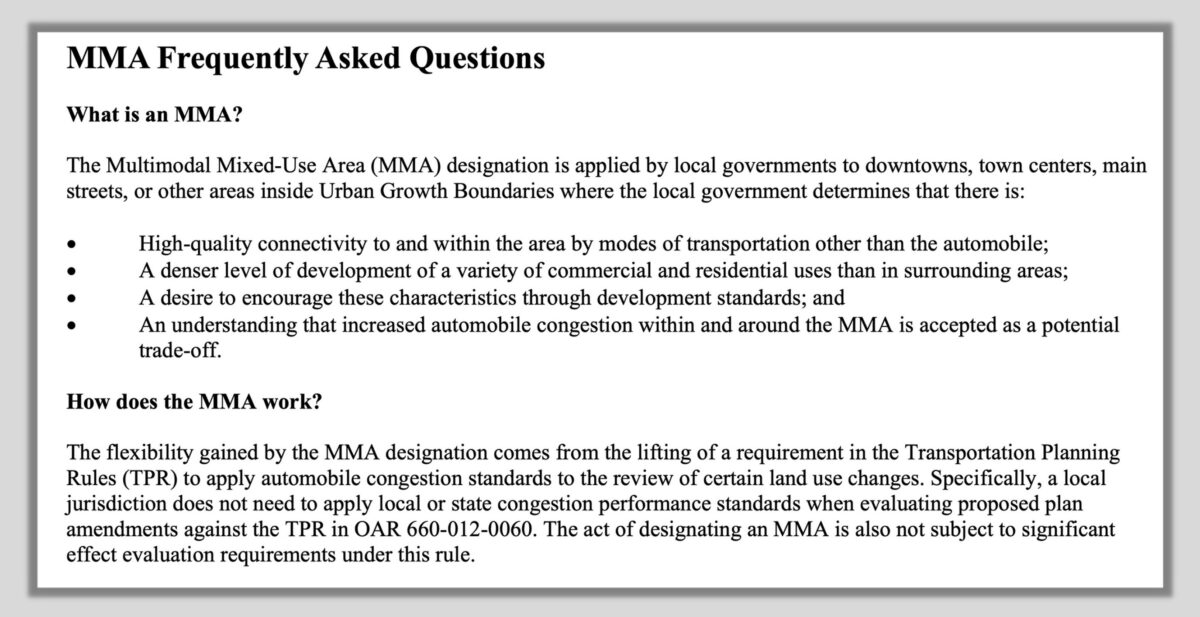
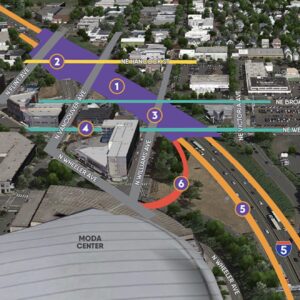
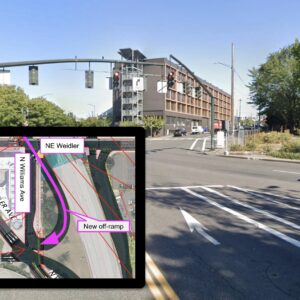

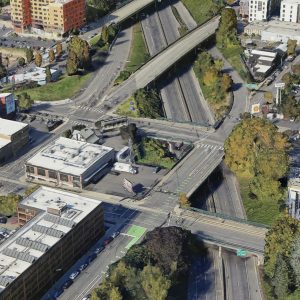
Thanks for reading.
BikePortland has served this community with independent community journalism since 2005. We rely on subscriptions from readers like you to survive. Your financial support is vital in keeping this valuable resource alive and well.
Please subscribe today to strengthen and expand our work.
Just curious, but has the state land use board ever opposed an ODOT project?
Wasn’t it the state legislature who initiated this project?
Good questions David… But IMO the bigger thing might be the discovery process. That is, forcing ODOT to show its work… something they have been reluctant to do as very smart engineers (like Brian Davis) and economists (Joe Cortright) have clearly pointed out.
You’re saying that PBOT could put a bullet through the heart of yhis thing?
Radical idea I put in my own comment to the SEA: if the on- and off-ramps are such a sticking point for safety, why don’t we just get rid of them entirely? There’s no reason that I-5 must provide direct connection to Broadway/Weidler, particularly when there is another connection just a few blocks south to Holladay/Multnomah and another a few blocks north to Overlook and Legacy Emmanuel. So much hand-wringing over a mostly redundant motorist convenience for a project that ostensibly about fixing freight shipping (imagine a dramatic eyeroll here).
Of course, I’d like to see I-5 realigned entirely out of the urban core…
That’s a great idea I’m sure ODOT’s response to that suggestion would be then you’re not providing the same level of service for drivers. Similar to their dogmatic adherence to the 80th percentile ODOT almost certainly has a LOS policy that says roadway expansions can’t reduce the LOS. Not that it’s a good excuse or anything or a requirement by the feds just something a lot of DOTs have operated with for decades.
I’m not sure I’d call it “dogmatic” — it’s hard to go back to the legislature and say “thanks for the money; rather than do what you directed us to, we used it to intentionally degrade driving conditions for your constituents. But at least it’s better to ride bikes there!”
This project has changed significantly since it was approved by the legislature in 2017. I don’t think it’s as hard as you’re assuming. ODOT could just say to get PBOT onboard we need to make this change. They’ve already done that multiple times. If anything is hard it’s going back to the legislature for three times the amount of money they originally approved. Heck it nearly doubled in the first year or two when they admitted their original estimate didn’t account for inflation.
That was literally their response to me (not verbatim but you get the idea) when I asked them that specifically in a prior iteration of the project. I’ve yet to see a state DOT actually take on a highway removal project that they thought would reduce level of service – post earthquake Embarcadero removal non withstanding.
There’s a prevailing notion that we need to do something about the historical wrong of urban freeway building, but as soon as a specific plan involves actually doing that, state DOTs immediately say the traffic resulting would be catastrophic (despite not having a very firm theoretical justification for that claim). Someone in the legislature needs to start championing some serious DOT administration reform to get away from whatever status quo we have now.
What specific plan involves undoing the wrongs of urban freeway building that DOTs falsely warn, without justification, would have catastrophic impacts?
Certainly nothing I’ve heard about in Portland meets that description.
And I’m not even sure the notion that highways were wrong is all that prevailing.
Regarding the notion that highway locations were wrong, part f of the Land Conversion and Development statute Jonathan linked says:
I would say both inaccessible design, and roadway/public infrastructure siting are both things that ODOT is almost solely responsible for.
When ODOT says things like:
they are invoking the idea that development is the issue for traffic, rather than the roadways themselves. They are saying “if you don’t build the RQ project, there will be catastrophic traffic issues and we will have to invoke our power to limit development in the name of traffic control”. Which is plainly against modern ideas about how traffic actually works.
ODOT claims to have sole knowledge about how traffic congestion works, but have yet to actually meaningfully prevent it.
I’m not following. You wrote:
What is the specific plan for undoing the “wrong of urban freeway building” that ODOT has wrongly claimed will have catastrophic impacts?
The RQ doesn’t match that description at all.
ODOT’s mandate is roads. If congestion is caused by development and landuse patterns, there’s not much they can do about that. A lot of people (not necessarily including me) think that development further from the urban core is good (or at least not inherently bad), and that congestion is a cost worth paying, so ODOT and, more importantly, the state legislature, is responding to that.
Adding the RQ project to the Central City Plan was very explicitly the price the City had to pay to get the MMA designation
Thanks Chris. I had a sense that was the case but it’s good to know from you that it absolutely was the case.
Chris, what would it take to designate other areas of the city MMA?
Thanks Will. I have been contemplating that as well, for other close-in areas. For instance BPS staff have told me that outer Powell Blvd, e.g., is close to the limit (traffic is at Level-of-service D, out of A-F), and a dozen more trips per day, and it will be out of compliance with Goal 12, which will affect or prohibit some upzoning, unless the MMA is expanded! Eager to here Chris’s advice on what State-level changes need to be made!
MMA’s only apply when you’re attempting to waive mobility standards on state facilities. So, other areas of the City do not need MMA’s unless they are dealing with a state highway (like Powell, formerly 82nd etc). MMA’s were originally conceived because many oregon communities have ‘main streets’ that are actually state highways (think of basically every coastal community, many in the valley, etc) and cities wanted to be able to use signal, crosswalks, etc to control vehicle speeds and improve ped environments despite impacts to congestion (potentially exceeding state mobility standards).
This is great coverage Jonathan.
So essentially the Devil went down to the Rose Quarter and made this deal with the City. ODOT thinks it backed the City into a corner by claiming that the City can’t realize the development goals of the Central City Plan in the No Build Scenario plan without the freeway expansion (and MMA). But Johnny is saying not so fast, we don’t need your freeway expansion to reduce congestion and make our City safer.
I just hope things work out as well as they did in the song.
Calling Tina Kotek, Kate Brown, and the democratic legislature the devil is not cool. How could we possibly stop the democratic establishment from expanding and funding freeways if we don’t strongly support them?
You are right, its not cool.
My main point is that granting the MMA in exchange for the Freeway Expansion feels like a Devil’s Deal. I just wanted to stretch the analogy to fit a pop-culture reference.
Wasn’t really intending to call anyone the Devil, except maybe the old-school institution of ODOT, since their policies are literally contributing to setting the planet on fire.
It’s really frustrating how those old-school pencil pushers at ODOT keep on defying the demands of their climate champion boss, Governor Kotek*. BTW, please vote for Governor Kotek in 2026 so she can finally hold old-school ODOT accountable!
*the fact that Tina Kotek helped push through a bill that explicitly directed the old-school ODOT pencil pushers to build the I5-RQ freeway expansion is completely irrelevant to this discussion!
It seems a little absurd that ODOT can use that to threaten the city of Portland with its “vehicle traffic mobility standards” to limit future growth. No wonder the Trail Blazers management group hates this project – it’s functionally extortion. Until ODOT recognizes that the unfettered vehicle access is what caused the destruction of the area in the first place, there’s no reason to think they will be able to come up with a good fix to the problem they created.
I thought the Blazers hated it because it would negatively modify traffic patterns used to access or leave their parking garages
Just rip out that section of i5 up to where it connects with 405, and return the east bank waterfront to the people. This whole project is mess.
You know what will restore lower Albina? Tearing out the highway
Albina will never be “restored”. All we can do is look forward to building something new. Hopefully it will work out better than Portland’s other grand redevelopment visions, but our track record is not good.
Yeah. The best we can do is halt the development of the King neighborhood. Solterra already built the Hilton there, and they want to keep going down into the African American neighborhood West of there. Caravan Tiny House Hotel also needs to be accountable for their sale to Solterra, the aforementioned developer from Seattle.
The Rose Quarter was an important project that Aaron Tarfmann opposes, and so I appreciate your help following the story.
The board of the Albina Vision Trust is composed of a retired NW Natural CEO, a luxury condo/apartment developer, a former buy-side investment manager, and a retired Aetna health insurance executive. The composition of this board illustrates how AVT is laser focused on mitigating the racist and classist harms of white supremacy.
Who says you cannot learn a lot from reading BP…for all these years when reading COP & ODOT planning documents I thought they were promoting Mixed Martial Arts (MMA) as a traffic solution. Oh well.
All the acronyms did have earlier referents in the article but some paragraphs were seriously alphabet soup. It was a hard read.
I thought ODOT had already committed to the MMA based on the central city planning process 10 years ago. It seems like they’re trying to use want leverage they have over the city and this is totally unacceptable
Hmm, MMA is stoo structured.
I’d like to advocate for the Thunderdome Solution:
Two Cars Enter
One Car Leaves
It’s interesting that a backup of motor vehicles from an offramp out onto the main traffic lanes of a freeway is a significant factor in local traffic planning. The ramp off I-5 N that ends at the SE Water Ave/SE Yamhill seems designed to fail. The surface street connection is almost entirely trapped behind railroad level crossings where long trains are either slow moving or even stopped.
A transportation department taking a global view of a transportation needs would either close off the exit, provide alternate routes, or eliminate the level crossings.
Unfortunately at this spot we have fiefdoms of two government agencies intersecting with a privately controlled legacy railroad that has dominant right of way and jealously guards its prerogatives.
If people really cared about bottlenecks on I-5 they would be working on this problem.